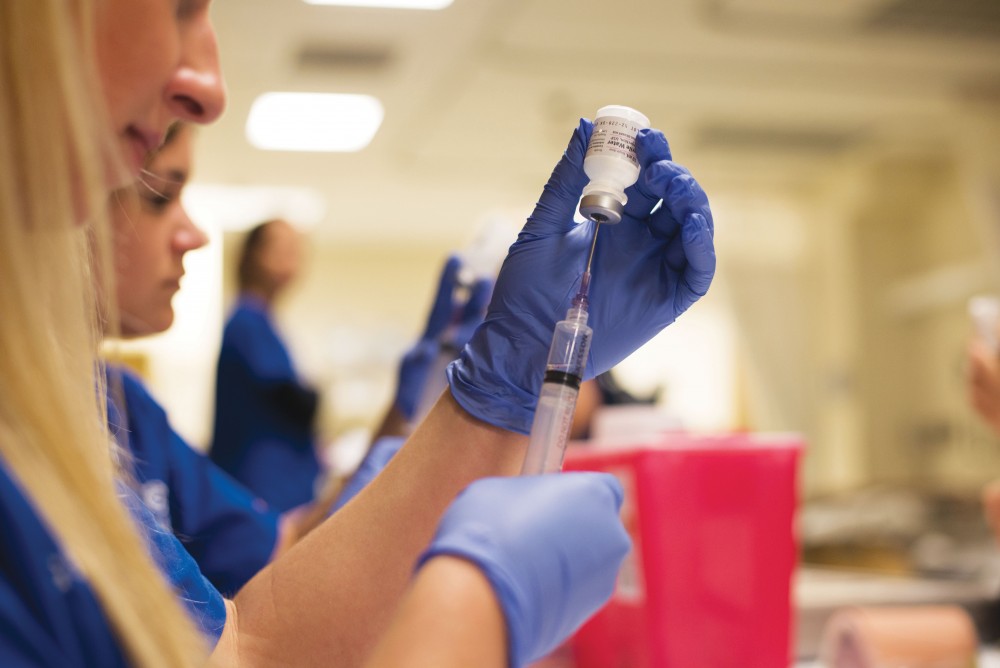Researchers find drop in rate of uninsured West Michigan residents

GVL / Luke Holmes – Megan Buchman practices giving a shot to a test dummy in the Center for Health Sciences building downtown on Monday, Sept. 26, 2016.
Jan 15, 2018
Grand Valley State University researchers have found that the percentage of uninsured residents in Michigan has dropped below 10 percent. The effect on West Michigan’s health economic forecast was also studied, with researchers finding that the downward trend is the lowest the rate has been in years.
Leslie Muller, assistant professor of economics at GVSU, and Kevin Callison, assistant professor of global health management and policy at Tulane University, worked to research this topic. They analyzed two different surveys that asked residents of West Michigan and Kent County about their health care, specifically what kind they had and what their savings were. This information helped them pinpoint the trend of health care in the area.
Although the uninsured rate of West Michigan has gone down, Muller found through her research that there are still barriers to obtaining medical care for some in West Michigan.
“The biggest barrier is cost; there were about two-thirds of people that said cost is the largest barrier from not getting health care, like going to the doctor and getting prescriptions,” Muller said.
She also explained that there are other barriers to receiving medical care that were indicated on the surveys, such as time off from work, child care and lack of transportation. However, these barriers will not affect the uninsured rate because even those who are not able to access medical care typically do have insurance—it just may be too difficult for them to receive actual care.
According to Muller, the health-care industry has been growing in West Michigan recently, which has increased the demand for a publication called Health Check. This is an annual publication run by the Seidman College of Business that tracks health behaviors, mainly of residents of West Michigan, while also gathering information from other health-insurance agencies.
Health Check is in its ninth year and is annually presented by a panel of researchers to explain the West Michigan Health Economic Forecast. Callison analyzed health trends that helped to create the forecast for the area and compared trends to the other side of the state in East Michigan. These findings resulted in discovering that the uninsured rate had dropped drastically.
“The share of those people with no health insurance in the state is down below 10 percent, and that is for the first time in essentially ever,” Callison said.
He credits most of the drop in the rate to the Affordable Care Act, including both the Medicaid expansion and health-insurance exchanges. While the ACA and other contributing factors have allowed the rate to drop lower than before, Callison says the downward trend will most likely level off or even increase depending on future changes to the ACA.
“It has led to some pretty significant system-wide changes in the health-care sector, but this (rate) will be fluid because of these policy changes happening at the federal level,” Callison added.
Muller and Callison used their research to discuss the implications their findings will have on West Michigan at the West Michigan Healthcare Economic Forecast on Friday, Jan. 12. The presentations were held in the L.V. Eberhard Center on the Pew Campus and discussed health-care trends in West Michigan.
The presentation held by both Muller and Callison focused on the data gathered from the two surveys they studied on the health-care forecast of the area. The surveys also helped them gather information on what is behind these health-care trends.
As for the uninsured rate, the direction it moves will rely on federal decisions, specifically the ACA, and will continue to be studied for the betterment of West Michigan and its residents.






















